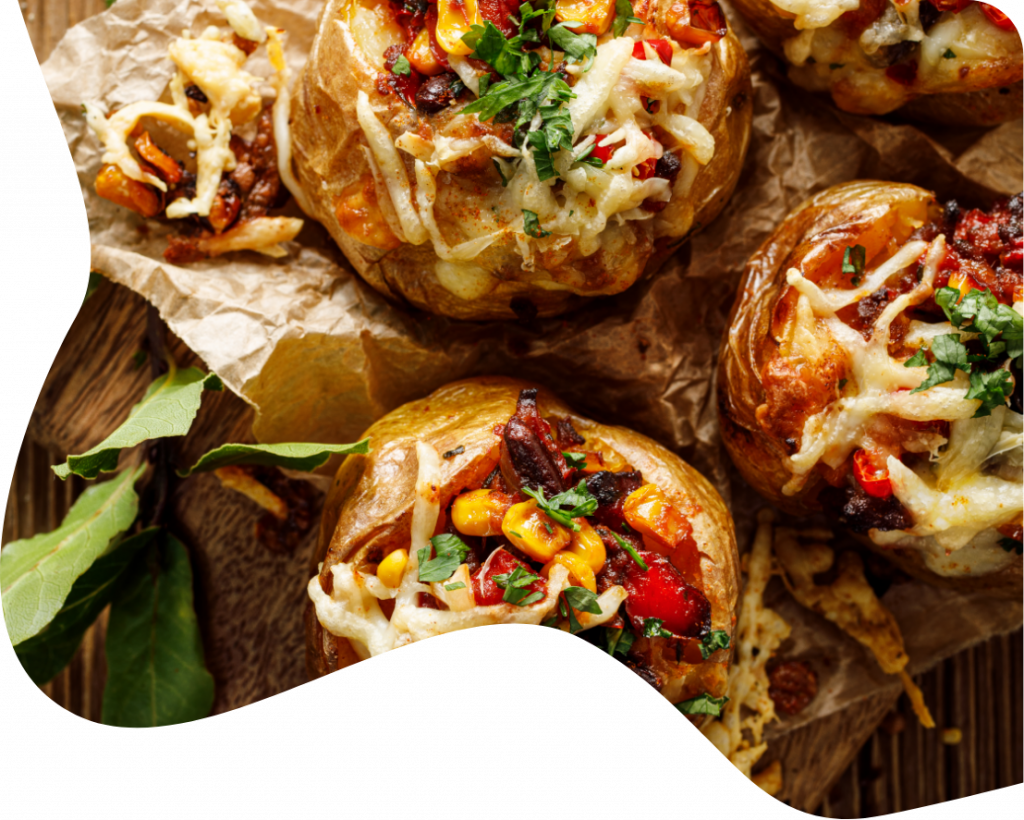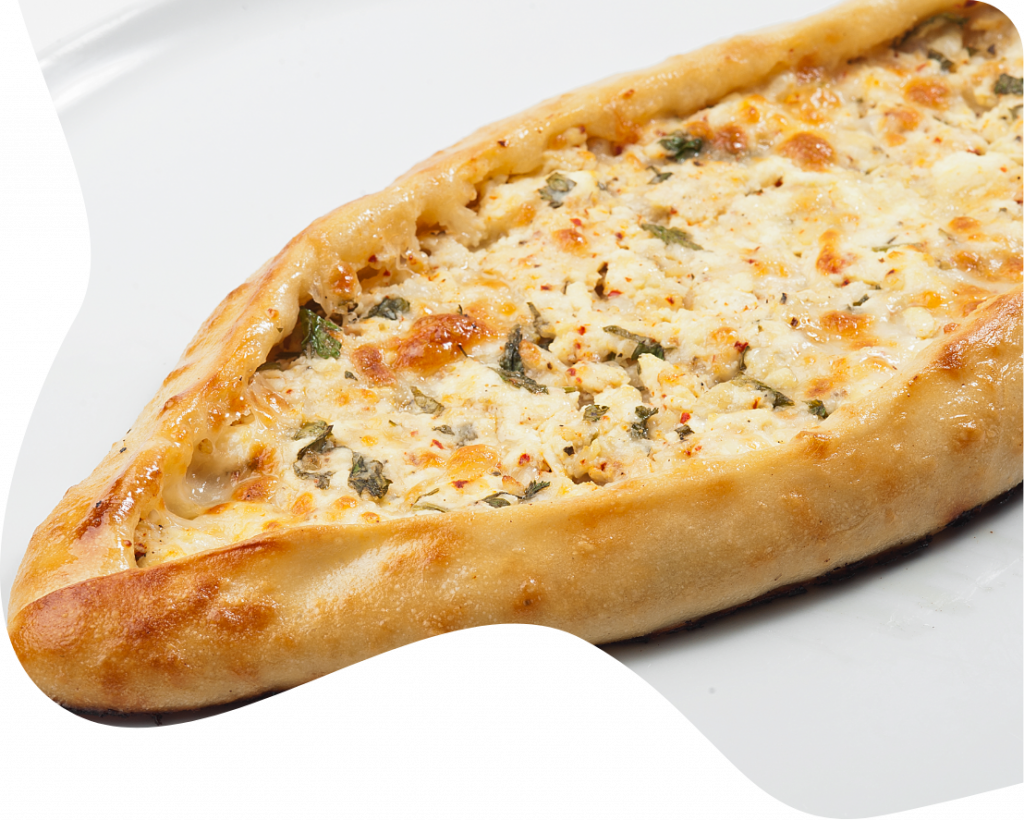BACK TO THE STREET – A CELEBRATION
OF STREETFOOD CULTURE
Welcome to Back to the Street – the celebration of street food culture!
It is our belief that street food is more than just food on the street - it's a global movement that has revolutionised food culture. Ranging from savoury to sweet, salty to sour - the variety of dishes and snacks is simply incredible. That's why we're bringing the Back to the Street campaign to the staff restaurant in Q3 2023, celebrating street food culture with delicious dishes and specialities. Let us take you on a culinary trip around the world!
Street food has a long and fascinating history, which dates back to the 19th century. Today, it is characterised by its simplicity, authenticity and unique taste. Street food offers a way to enjoy good food quickly and cheaply. Although it can vary from country to country, it still has one mutually-shared element:
Street food preparation methods are as varied as the dishes themselves. Every region, country and culture has its own traditional techniques that have been passed down through generations. This is what makes street food so unique and authentic.
One of the most distinctive features of street food is that it is prepared right in front of the customers. In busy markets or food trucks, you see chefs skilfully juggling, frying, grilling, and deep-frying. This live preparation creates a special connection between the chef and the guests, and watching them do it is really fascinating, too.
Street food preparation methods cover a wide range of techniques. In Asian cuisine, wok frying, steam cooking, and using tandoori ovens are common. In Latin America, grilling, frying in a pan and using masa dough for tortillas and empanadas are common practices. In Europe, grilling sausages, frying fish and baking crepes are popular.
Another characteristic of street food is the use of fresh and high-quality ingredients. Most street food dishes are prepared with local products, thereby ensuring an authentic taste and freshness. You can often find local farmers and producers at street food markets who deliver their fresh ingredients directly to the street vendors.
Preparing street food often calls for skill and speed. The chefs have to be able to handle several orders simultaneously, and still ensure the quality and taste of the dishes. It is a true craft that requires years of experience and practice. The fine art of street food is the harmonious combination of flavours, spices and textures to create a taste experience that delights the senses. It is this passion and dedication to the craft that makes street food such a unique culinary experience.
Street food preparation methods are as varied as the dishes themselves. Every region, country and culture has its own traditional techniques that have been passed down through generations. This is what makes street food so unique and authentic.
Whether you're out and about in the alleyways of Bangkok, Mexico City or Istanbul, or trying to prepare street food dishes at home, the secret is to capture the spirit of street food and conjure up the tastes and flavours of the world on your plate. It's a journey of discovery for the palate, getting to know the diversity and cultural treasures of street food.
The history
and characteristics
streetfood

STREET FOOD IS NOT ONLY DELICIOUS
IT ALSO COMES WITH SOME BENEFITS:
Freshly prepared
It offers a range
of healthy options.
It is usually reasonably priced
It is usually rapidly available.
THE VARIETY OF
STREET FOOD
You can find an incredible variety of street food dishes around the world.
From noodle dishes in Asia, to empanadas in Latin America and poutine in Canada; the range of possibilities are endless. Most dishes are quick and easy to prepare and often freshly made in front of customers. That's what makes street food so special - it's fresh, delicious and brimming with flavour.
Churros – The popular
pastry from Spain
Taco al pastor – The popular Taco Mexico
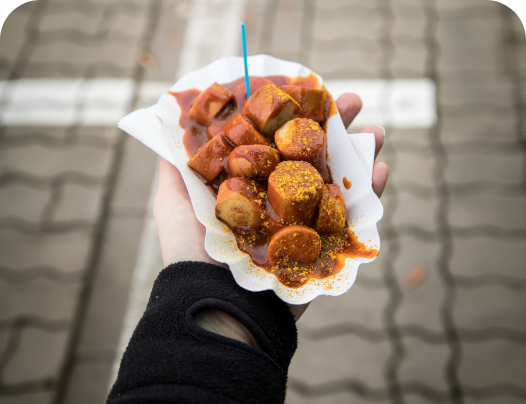
Currywurst - The cult-sausage from Germany
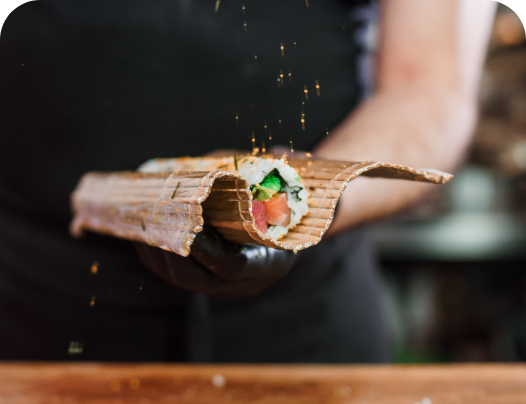
Sushi –The traditional art from Japan
Crêpes – Delicious pancakes from France
streetfood
WORLDWIDE
STREETFOOD -
TOTALLY TRENDY
Street food has evolved in recent years and new trends and innovations are popping up all the time. There are healthy alternatives and vegan options. The way street food is sold has also changed - more and more food trucks and mobile kitchens are taking over the streets. At Back to Street, we bring these trends to you, allowing you to enjoy the latest and most exciting taste experiences.
METHODS OF PREPARATION

1. Grilling
Meat, fish or vegetables are grilled on a hot grill grate to create a smoky aroma and crispy texture.
2. Deep-frying:
Deep-frying food is a technique that is popular in many Asian cuisines, such as making crispy spring rolls in China or tempura in Japan. Food is fried in hot oil, creating a crispy outer layer and a tender, juicy inside.
3. Wok frying:
Ingredients are briefly fried in a hot wok with oil, soy sauce and spices, which retains their natural freshness and crunchiness. This method is typical of Chinese cuisine and is used to cook ingredients quickly and gently, while preserving their natural flavours and textures.
4. Steaming:
Food is cooked over boiling water in a steamer, preserving its texture and nutrients. Steaming food is especially common in Chinese and Korean cuisine, and it keeps ingredients tender and juicy while retaining their nutrients.
5. Roasting:
Spiced nuts, seeds or spices are roasted in a pan to intensify their flavour and create a crunchy bite. It is used in many culinary traditions to intensify the flavour, such as in the preparation of garam masala in Indian cuisine.
6. Wrapping:
Ingredients such as meat, vegetables or rice are wrapped in dough or leaves and steamed or fried to create a compact and portable snack. This method is common in various cuisines, such as banh mi in Vietnam, dolma in Turkey or tamales in Latin America.
7. Marinating:
Meat, fish or vegetables are marinated in a spicy mixture of oil, spices and juices to intensify the flavour and tenderise the meat. It is a common method to enhance the flavour and achieve the tender texture, such as in satays in Indonesia or churrascos in Argentina.
8. Flambé:
A 40+ per cent alcohol is poured over a dish and ignited to create a theatrical effect and enhance the flavour. It is particularly popular in French cuisine to create a decorative effect and intensify the flavour, such as in the preparation of crêpes suzette.
9. Poaching:
Eggs, meat or fish are cooked in simmering water to create a tender and juicy texture. Many cuisines use this method to achieve a tender and juicy texture, such as in Eggs Benedict in American cuisine or in the preparation of fish in the Mediterranean region.
10. Mixing:
Different ingredients are combined and blended with spices and sauces to create a variety of flavour dimensions, as in a salad or a stew. This method of preparation is commonly used in many cuisines to create complex flavour profiles, for instance with curries in India or salsas in Mexico.
WE BRING STREET FOOD
TO YOUR HOME
The smell of delicious street food at a market or food truck can be irresistible, and now you can also enjoy it at home. With a few simple tips and tricks, you can turn your kitchen into a street food paradise and bring the flavours and smells of the world to your home. We now show you simple and delicious recipes that anyone can try. Whether you would like to try your hand at the famous Tacos al Pastor from Mexico or the Thai Pad Thai, with a little practice and the right instructions you are sure to become a street food expert at home and can set off on a culinary journey around the world.
Mecican
Kumpir
Kumpir ingredients:
4 large potatoes (mainly waxy)
2 tablespoons olive oil
Salt and pepper to taste
Chilli con Carne ingredients:
500 g minced beef
1 onion, finely chopped
2 cloves of garlic, chopped
1 red bell pepper, diced
1 green bell pepper, diced
1 can (400 g) chopped tomatoes
1 can (400 g) red kidney beans, drained
1 tsp ground cumin
1 tsp ground paprika
1/2 tsp ground oregano
1 pinch of cayenne pepper (optional for extra spiciness)
Salt and pepper to taste
2 tablespoons olive oil
200 ml beef stock
Instructions:
Preheat the oven to 200°C. Brush the potatoes with olive oil and season with salt and pepper. Individually wrap the potatoes in aluminium foil and place on a baking tray. Bake the potatoes in the oven for about 60-70 minutes until they are soft.
Heat the olive oil in a large frying pan or pot. Add the chopped onion and garlic and sauté until translucent.
Add the minced beef and fry until brown and crumbly. Add the diced peppers and cook for another 3-4 minutes until they become slightly softer. Add the chopped tomatoes and drained kidney beans and stir. Now add the cumin, ground paprika, oregano and cayenne pepper (if using). Stir in the beef stock to dilute the mix. Season the chilli con carne with salt and pepper. Cover the chilli mixture and simmer for about 20-25 minutes, at low heat, to allow the flavours to mix.
Remove the jacket potatoes from the oven and carefully unwrap from the aluminium foil. Cut each potato lengthwise and gently push apart. Pour a little chilli con carne over each potato. Garnish with grated cheese, sour cream (or Greek yoghurt) and chopped spring onions. Serve with guacamole or avocado slices if desired.
Mediterranean vegetable pide, with shepherd's cheese and hummus (serves 4)
Ingredients:
For the pide dough:
400 g flour (type 550 or 405)
1 packet of dry yeast (approx. 7 g)
1 tsp sugar
1 tsp salt
250 ml lauwarmes Wasser
2 tablespoons olive oil
For the Mediterranean vegetables:
1 red bell pepper, cut into cubes
1 yellow bell pepper, cut into cubes
1 courgette, cut into cubes
1 aubergine, cut into cubes
1 red onion, cut into rings
3-4 garlic cloves, finely chopped
2 tablespoons olive oil
1 tsp dried oregano
Salt and pepper to taste
For the topping:
200 g shepherd's cheese, crumbled
Preparation:
Prepare the dough:
In a bowl, mix the flour with the sugar and the salt. Make a hollow in the centre and add the dry yeast. Pour the lukewarm water and olive oil into the hollow. Using a fork or your hands, slowly mix the flour with the liquid until you have a dough. Knead the dough on a lightly-floured surface until it is smooth and elastic. Cover the bowl with a clean cloth and leave the dough to rise in a warm place for about 1 hour until it has doubled in volume.
Prepare the Mediterranean vegetables:
Heat 2 tbsp olive oil in a pan and sauté the red onion and garlic until fragrant. Add the sliced peppers, courgette and aubergine and fry over medium heat until the vegetables are soft. Season with oregano, salt and pepper. Remove from the heat and set aside.
Prepare the hummus:
Puree the cooked chickpeas, garlic, tahini, lemon juice, olive oil and cumin in a blender or food processor until a smooth paste is formed. If the hummus is too thick, a little water can be added to achieve the desired consistency. Season with salt and pepper.
Bake the pide:
Divide the risen dough into 4 equal pieces. Roll each piece on a floured surface, forming it into an oval patty. Preheat the oven to 220 °C top-lower heat (200 °C fan oven). Place the patties on a baking tray lined with baking paper. Spread some of the Mediterranean vegetables on each patty and sprinkle with shepherd's cheese. Bake the pide for about 12-15 minutes until the dough is golden brown and crispy.
Serve:
Remove the freshly baked pide from the oven and arrange on a serving plate. Serve with the homemade hummus and garnish with fresh herbs if desired.
Falafel wrap, with beetroot and walnuts (serves 4)
Ingredients:
For the falafel:
250 g dried chickpeas (soaked overnight) or 2 tins of chickpeas (drained)
1 onion, roughly chopped
3-4 cloves garlic, chopped
1 bunch fresh parsley, roughly chopped
1 tsp ground cumin
1 tsp ground cumin
Salt and pepper to taste
2-3 tbsp olive oil (for frying)
For the wrap:
4 large tortilla wraps
200 g beetroot, cooked and cut into thin slices
100 g walnuts, roughly chopped
Fresh spinach or lettuce to taste
4 tbsp hummus (bought ready-made or homemade, see hummus recipe in previous recipe)
Preparation:
Prepare the falafel:
If you are using dried chickpeas, rinse them well after soaking and drain. Blend all the ingredients for the falafel (chickpeas, onion, garlic, parsley, cumin, coriander, salt and pepper) in a blender or food processor, until you have a coarse paste. Place the mixture in a bowl and leave in the fridge for about 15-30 minutes. This way, the flavours can unfold and the mixture can become firmer. Shape the mixture into small balls and gently flatten them to create the classic falafel shape. Heat the olive oil in a frying pan and fry the falafel over a medium heat until golden brown and crispy on both sides. Drain on a paper towel.
Prepare the yoghurt dressing:
Mix the Greek yoghurt with the lemon juice, chopped garlic, salt and pepper. Season according to taste.
Create your wrap:
Open up a tortilla wrap on a work surface. Spread a generous amount of the yoghurt dressing on the wrap. Place a handful of fresh spinach or lettuce in the centre of the wrap. Sprinkle beetroot slices and chopped walnuts on top. Place the fried falafel balls on top.
Roll the wrap:
Fold the side edges of the wrap slightly inwards so that the filling does not fall out. Roll up the wrap, starting from the bottom side, until everything is tightly closed. Repeat the process for the remaining wraps.
Serve:
Cut the falafel wraps in half or leave them whole and arrange on plates. Serve with additional yoghurt dressing or hummus as desired
BBQ Pulled Pork Fries with Coleslaw (serves 4)
Ingredients:
For the BBQ Pulled Pork:
1.5 kg pork shoulder (pork), boned
1 large onion, chopped
4 cloves of garlic, chopped
250 ml BBQ sauce (to taste, homemade or bought)
250 ml chicken stock
2 tbsp brown sugar
1 tbsp mustard
1 tsp smoked paprika powder
1 tsp ground cumin
Salt and pepper to taste
2 tablespoons olive oil
For the French fries:
1 kg potatoes (waxy)
2-3 tbsp olive oil
Salt and spices to taste (optional)
Preparation:
Prepare the BBQ Pulled Pork:
Preheat the oven to 160°C. Season the pork shoulder with salt, pepper, smoked paprika powder and ground cumin. Heat the olive oil in a large roasting pan or frying pan and sear the seasoned pork shoulder on all sides until it forms a golden brown crust. Add the chopped onion and garlic and fry briefly.
Add the BBQ sauce, chicken stock, brown sugar and mustard to the roasting pan. The liquid should reach about halfway up the meat. Cover the roaster with a lid or aluminium foil and braise the meat in the preheated oven for about 3-4 hours, until tender and slightly falling apart. Remove the pulled pork from the roaster and use two forks to pull it into fibres. When doing this, pour off the excess liquid, but use some of it for the pulled pork.
Prepare the fries:
Peel the potatoes and cut into thin strips to make fries. Mix the fries in a bowl with olive oil and spices to season them. Place the fries on a baking tray and bake in a preheated oven at 220°C for about 25-30 minutes until crisp and golden brown.
Prepare the coleslaw:
Place the shaved or chopped white cabbage and shredded carrots in a large bowl. Mix the mayonnaise, apple cider vinegar, sugar, salt and pepper in a small bowl. Pour the dressing mixture over the cabbage and carrots. Mix well until everything is well coated. Leave the coleslaw in the fridge for about 20-30 minutes, for the flavours to develop.
Arrange the BBQ pulled pork fries:
Arrange the crispy fries on a large plate or serving platter. Spread the tender pulled pork generously over the fries. Serve the coleslaw as a side dish alongside the pulled pork fries.
LOOK FORWARD
TO THE CAMPAIGN
Street food has changed the way we enjoy food on the street. It's colourful, diverse and always good for a surprise. But what about the food in the canteens?
Our chefs at apetito catering have decided to do justice to this with this campaign. With the Back to the Street campaign, they are bringing street food culture back to the canteens - and with great gusto! Discover the delicious dishes and specialities from across the globe and be inspired by the diversity of street food.

